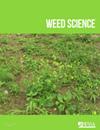野生萝卜(Raphanus raphanistrum)开花时间的适应性,第 1 部分:基于个体的多基因性状建模
IF 2.5
2区 农林科学
Q2 AGRONOMY
引用次数: 0
摘要
本研究利用种群模型 SOMER(抗性进化空间定向模型),对野生萝卜(Raphanus raphanistrum L.)进行了六代基于温室的花期选择复制研究。之所以选择这种基于个体的模型,是因为它可以改变为包含不同数量的基因,以及环境对表型的不同影响程度(即遗传率)。在没有中间调整的情况下,精确复制了之前基于玻璃温室的选择过程中发生的六代遗传变化。这项研究发现,只需要两个基因的多个拷贝,就能再现之前研究中证明的多基因花期适应性。该模型包括具有连锁和交叉作用的主要效应型 M1 基因,以及独立变异的次要效应型 M2 基因。在该模型中,M1 基因的传递率(每种基因类型的遗传率)参数化为 0.60,M2 基因的传递率参数化为 0.45。在种群模型中对 R. raphanistrum 的花期遗传学进行参数化意味着,模拟研究外部杂草控制对花期适应性的影响变得更加可行。基于孟德尔模型的精确简化模型复制了由一系列复杂基因控制的开花时间的适应性变化,有助于预测生命周期的适应性,以规避杂草控制措施(如收割杂草种子控制),这些措施对影响种子保持力(包括开花时间)的性状进行了强烈的适应性选择。本文章由计算机程序翻译,如有差异,请以英文原文为准。
Adaptations in wild radish (Raphanus raphanistrum) flowering time, Part 1: Individual-based modeling of a polygenic trait
This study investigated replicating six generations of glasshouse-based flowering date selection in wild radish (Raphanus raphanistrum L.) using an adaptation of the population model SOMER (Spatial Orientated Modelling of Evolutionary Resistance). This individual-based model was chosen because it could be altered to contain varying numbers of genes, along with varying levels of environmental influence on the phenotype (namely the heritability).
Accurate replication of six generations of genetic change that had occurred in a previous glasshouse-based selection was achieved, without intermediate adjustments. This study found that multiple copies of just two genes were required to reproduce the polygenic flowering time adaptations demonstrated in that previous research. The model included major effect type M1 genes, with linkage and crossing over, and minor effect type M2 genes undergoing independent assortment. Within the model, transmissibility (heritability of each gene type) was parameterized at 0.60 for the M1 genes and 0.45 for the M2 genes. The serviceable parameterization of the genetics of flowering in R. raphanistrum within a population model means that simulated examinations of the effects of external weed control on flowering time adaptations are now more feasible. An accurate and simplified Mendelian-based model replicating the adaptive shifts of flowering time that is controlled by a complex array of genes is useful in predicting life-cycle adaptations to evade weed control measures such as harvest weed seed control, which apply intense adaptive selections on traits that affect seed retention, including flowering time.
求助全文
通过发布文献求助,成功后即可免费获取论文全文。
去求助
来源期刊

Weed Science
农林科学-农艺学
CiteScore
4.60
自引率
12.00%
发文量
64
审稿时长
12-24 weeks
期刊介绍:
Weed Science publishes original research and scholarship in the form of peer-reviewed articles focused on fundamental research directly related to all aspects of weed science in agricultural systems. Topics for Weed Science include:
- the biology and ecology of weeds in agricultural, forestry, aquatic, turf, recreational, rights-of-way and other settings, genetics of weeds
- herbicide resistance, chemistry, biochemistry, physiology and molecular action of herbicides and plant growth regulators used to manage undesirable vegetation
- ecology of cropping and other agricultural systems as they relate to weed management
- biological and ecological aspects of weed control tools including biological agents, and herbicide resistant crops
- effect of weed management on soil, air and water.
 求助内容:
求助内容: 应助结果提醒方式:
应助结果提醒方式:


